How to Fight Clutter in the Cockpit
I love telling people I have the world’s greatest office view. The only bad part about my office and the incredible view is the occasional lack of space. Cockpits can be pretty cramped spots to begin with and then when you add sectional charts, plotters, calculators, E6Bs, AFDs, sunglasses, pens, etc. well…it can get pretty messy pretty quickly as is the case apparently with Mark.
Mark wrote me asking:
I have recently started flying again after a break of 10 years and am trying to upgrade to a CPL. I am having quite a bit of trouble getting organised in the cockpit on nav flights. I’m always dropping my ruler, protractor or computer, charts keep flapping around everywhere…..and where’s that bloody pencil gone? I can’t remember it being this hard when I first got my PPL. Any practical advice would be greatly appreciated. My instructor keeps telling me “to have a place for everything and keep everything in its place”. It’s easy for her to say when all she’s holding is a note book, jotting down my numerous mistakes for our post flight briefing…I thought any other input I could get wouldn’t hurt. I’ve got a decent clip board with clips and sleeves and stuff – but everything always seems to end up out and all over the place. What can you tell me to help me tidy myself up a bit?
Hi Mark! First of all, thanks for your question and I’m glad to hear you’ve started flying again. I’ll be honest, staying organized in the cockpit is something I struggle with as well. When I have 5 or 6 legs and each leg has 4 pages of wind and weather printouts you can imagine papers and charts flying all over the place and yes, where is that darn pen? (A little side note: I flew into Oshkosh this year penless! I couldn’t find anything to write with…of course until after I landed.)
I have a couple recommendations.
Think outside the box. I’ll give you some product recommendations below but first here are some other practical tips for reducing clutter in the cockpit:
- Cargo Pants. The current official military flight suit is CWU 27/P. The next time you see one (at an airshow maybe?) you’ll notice pockets are everywhere. There are pockets on the chest, arms, and pants. I’m not recommending that you wear a pilot suit for training (unless you want to) but cargo pants are a great alternative. You can store a pen, a small E6B or CR2, and even a small notepad for copying weather and clearances. Thanks to @RyanBummy for that suggestion.
- Reduce paperwork by coming up with your own checklist. This could be a whole post in and of itself (and probably should be) but by creating your own checklist you can organize and de-clutter the cockpit by including things on the checklist that you might have normally would have on a separate piece of paper.
- Along those sames lines is creating your own flight plan form. Maybe you can use Word or Excel to come up with your own navlog / flight plan template. Anytime you can reduce the amount of paper by even one sheet, you help make a cleaner (and greener) cockpit.
Besides reducing the amount of paperwork you bring on board, it also helps to have, as your flight instructor said, a place for everything and everything in it’s space. So here are a couple pilot product recommendations for helping your organize the cockpit:
- Kneeboards. You mentioned that you already have a decent kneeboard, but just wanted to toss my personal recommendation for the Ultimate Kneeboard. A great kneeboard especially for instrument training.
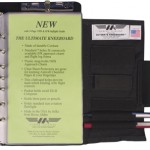
- Clipboards. There are a couple variations I’ve seen on this.
- Cockpit Organizers
One is an aluminum clipboard with about a 1″ storage pocket. I’ve seen a lot of flight instructors use these. In fact, I’ve found a couple that actually come with VFR / IFR cheat sheets printed on them. These are great because you can clip a navlog or blank sheet of paper on top and store charts, future navlogs, etc underneath in the storage area. The aluminum is very durable too. This option is a little bulky but durable.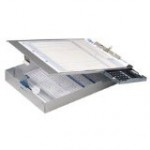
Plastic clipboard with calculator. This is what I’m using now. The plastic versions are a littler slimmer and slide right between the sidewall and my cockpit chair, a perfect fit. I can store all those flight logs, weather pages, insurance forms,VOR logs, etc in the storage pocket. The calculator on my particular clipboard is also handy in case I need to do some number crunching real quick.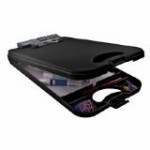
Dual Headset Bag. This is my personal default headset bag. I use a dual headset bag because I can store my headset on one side and use the other side for storing plotters, E6B, earplugs, snacks, gum etc. When I need something from the storage pocket during flight I usually just reach in and feel around. If I need to get something out of my way, I just toss it in one of the pockets and figure it out later. The dual headset bag that I own also has a couple of side pockets for storing checklists, pens and the fuel tester. Of course, if I need to actually carry two headsets, it’s pretty good for that too.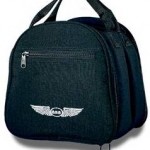 Sporty’s Pilot Shop has a “Senior Pilot’s Caddy” and while I haven’t used this particular model it looks like others I’ve seen used in the past. You can store charts, books, headsets, fuel testers, pens, etc and it still is small enough to fit perfectly between the seats of most training aircraft.
Sporty’s Pilot Shop has a “Senior Pilot’s Caddy” and while I haven’t used this particular model it looks like others I’ve seen used in the past. You can store charts, books, headsets, fuel testers, pens, etc and it still is small enough to fit perfectly between the seats of most training aircraft. 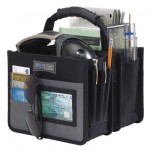
BrightLine Pilot Flight Bag. BrightLine has a new Pilot Flight Bag that looks amazing. If you read the history of the company, the president says the motivation for starting the company was exactly the same problem you are facing now. Several instructors that I know recommend this pilot flight bag.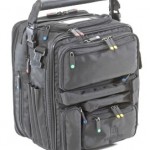
In conclusion, you might find a combination of clipboard and an organizer works bests for you. I am the type of person that wants to bring everything (just in case) but ends up using very little of it. Over time, I’ve found what I actually use on a flight and only bring that. You’ll find flying (and traveling) more enjoyable if you pack light and just bring the essentials. It is also much easier to stay organized in the cockpit that way.
I hope I’ve given you a couple of suggestions that will help and have fun and stay organized in your flight training and most importantly….
Fly Safe!
Feel free to chime in with your own cockpit organization suggestions to help Mark out!


Curdle1 on Sep 16, 2009
Great post! I am so disorganized especially when it comes to having approach plates. Since I’m learning to fly them I need to have the book with me at all times. My instructor recommended black metallic binder clips to hold the page open. This has worked wonders for me. It keeps the page of the approach I am flying open and the book in a firm position without pages flying everywhere.
Patrick Flanigan on Sep 17, 2009
Clutter is the enemy! In the CRJ I literally have a ton of space. Two built in clipboards and a big empty area on the side of the cockpit that works well as a desk (complete with cupholder!) has made me lazy.
Back in the local Cessna, I operate as a creature of habit, and I think that’s the real trick. You need to define some sort of organization system. The E6B always goes here. Charts are always over there. Whatever works for you, make it a habit and maintain consistency.
And don’t forget about to use passengers as needed! If you need something from your flight bag, it’s a whole lot safer to have a passenger get it out rather than going “heads down” for a few moments to do it yourself. Sure, this isn’t really an option during corporate or charter ops, but when you’re flying with your friends, put them to work!
Paul on Sep 17, 2009
Thanks for the comments and additional suggestions. Those black metallic binder clips are a great idea and something I use personally when flying with NACO charts.
Robert on Sep 17, 2009
I use the Ultimate Kneeboard and it is great. Especially for center stick aircraft. As to your point on creating your own checklists, I created my own and printed them on paper the size that would fit in each of the pages. This way I just flip from page to the next instead of fumbling for the checklist.
I also use the Brightline Flight Bag. It is amazing. There are so many pockets and I keep finding more. I especially like that you can remove one part (where I keep my XC stuff) so that if I am only doing local practice flights I don’t have to carry the full bag. This is great especially since I fly an LSA with very little baggage space.
Sylvia on Sep 17, 2009
I can highly recommend making your own checklists and flight-plan form. I have a template that I fill in with pertinent details on the computer and then print out.
The clipboard looks interesting, I’ve been thinking of replacing mine but wasn’t really sure what would be an improvement.
I have a small bag with ruler, protractor etc that is stashed behind my seat – but to be fair, with the gps system and my obsession with planning every detail before we leave, I can’t remember the last time I used one in flight.
Paula Williams on Sep 21, 2009
Just got my private license this month!
This has been one of my biggest problems. Love the suggestion about cargo pants (although the ones they make for girls are usually not quite as useful, and the ones made for guys look pretty dorky on some of us.)
Patrick’s suggestion about using your passengers is also great.
My suggestion is to use little black binder clips on everything. You can use as many as you need, clip things to the tops and bottoms of your kneeboard and/or organizer.
The other suggestion is to use colored highlighters. Use your own system (one color for each leg, or whatever works for you) so that you don’t mistake one row or column for another.
Thanks for a great article!
Julien on Sep 22, 2009
One instructor I used to fly with always kept sick bags in the left knee pocket of his cargo pants. I guess he had to clean the airplane one time too many after steep turns on a warm day 🙂
I use these little coil things that you can clip to a regular clipboard. They can hold three pens. I create mud maps with the essentials for each leg (heading, time, distance, frequencies, elevations, circuit direction, etc.), they help a lot with reducing the number of documents I need to have on my lap.
And finally: nothing so far has taught me more about cockpit organisation than night flying. You just need to know where everything is, because if you start looking for it, you won’t find it.
Un-cluttering the cockpit — Golf Hotel Whiskey on Sep 23, 2009
[…] it might be time to consider getting better organized. Hence, Paul Tocknell’s recent post about clutter in the cockpit (or specifically, ways to un-clutter the cockpit) is well worth reading. Some of his simple and […]